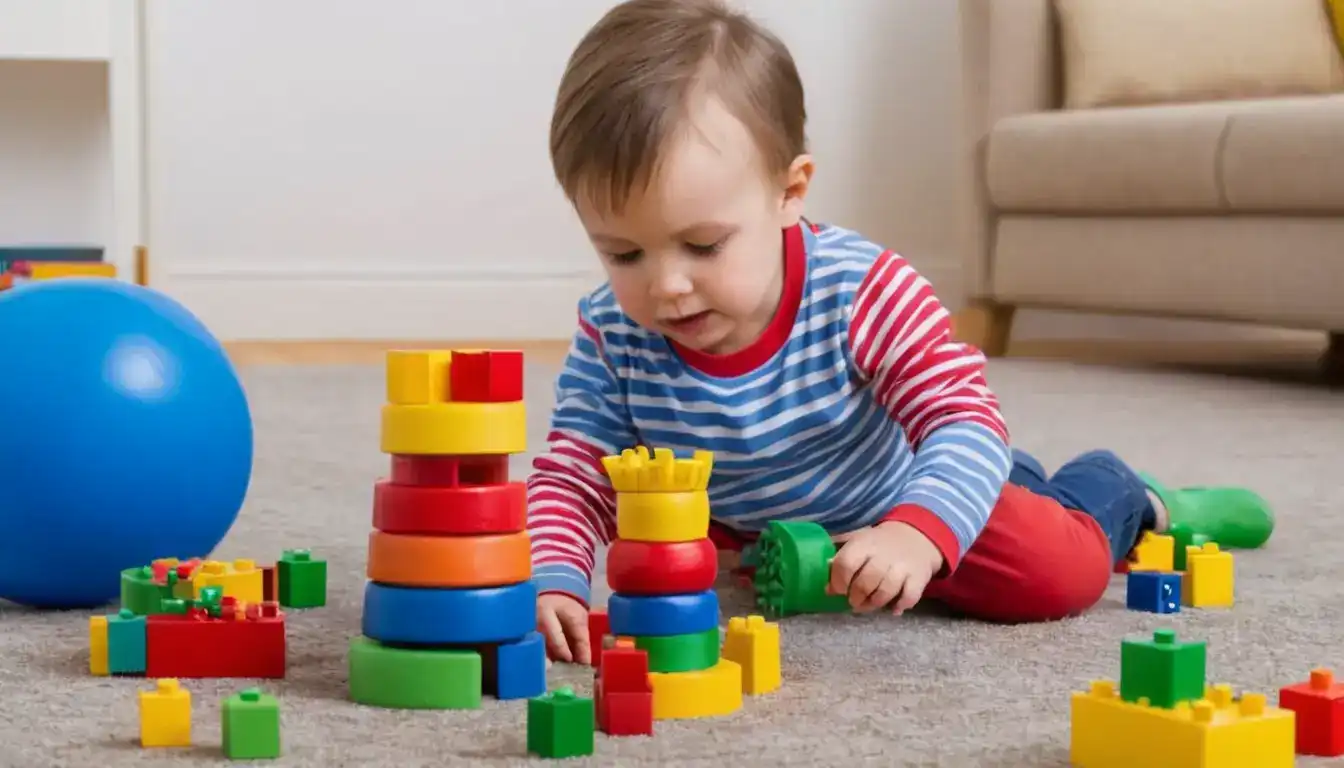5 Ways to Improve Early Childhood Fine Motor Skills at Home
Emily Willis

Photo: 5 Ways to Improve Early Childhood Fine Motor Skills at Home
Fine motor skills are the small movements we make with our hands and fingers. These skills are crucial for everyday tasks like dressing, writing, and eating. The good news is that developing these skills can be a fun and engaging experience for both children and caregivers. This article explores five creative ways to nurture your child's fine motor skills at home, transforming everyday activities into playful learning opportunities.
1. Playful Exploration with Playdough
Playdough is a classic for a reason! It's a versatile and mess-free (well, mostly!) medium that encourages exploration and strengthens fine motor skills. Here are some engaging playdough activities for different age groups:
- Ages 1-2: Start simple! Provide your child with a variety of brightly colored playdough and encourage them to squish, roll, and pat it. You can even show them how to make indentations with their fingers or use cookie cutters to create basic shapes.
- Ages 2-3: As your child's hand-eye coordination develops, introduce tools like rolling pins, plastic knives, and cookie cutters. Help them roll out the playdough, "cut" shapes, and create simple objects like snakes or pretend cookies.
- Ages 3-4: The fun gets more advanced! Encourage your child to create more complex shapes, figures, or even miniature scenes. You can introduce them to the concept of colors by asking them to sort playdough by color or create a rainbow serpent.
Beyond Playdough:
- Sensory Play: Sensory play activities incorporating materials like rice, beans, or sand can improve fine motor skills and provide a stimulating tactile experience. Let your child scoop, pour, and sift these materials, encouraging them to use their hands and fingers.
- Finger Painting: Finger painting allows children to explore colors and textures while strengthening their grip. Provide them with washable paints and large sheets of paper or a plastic surface for a messy yet enjoyable experience.
2. Building and Stacking: A Block Party for Fine Motor Skills
Building blocks are a timeless toy that fosters creativity and problem-solving skills while enhancing fine motor development. Here are some ideas to maximize their learning potential:
- Ages 1-2: Start with large, colorful blocks that are easy for your child to grasp and stack. Demonstrate how to build simple towers, encouraging them to imitate you.
- Ages 2-3: Introduce a variety of block shapes and sizes. Help your child build taller towers, experimenting with balance and stability. You can also incorporate toy cars or animals to create imaginative play scenarios.
- Ages 3-4: The building gets more complex! Challenge your child to build specific structures like bridges, houses, or towers with a specific number of blocks. This encourages planning and fine motor coordination.
Beyond Building Blocks:
- Threading Activities: Threading beads, pasta, or cereal loops onto a pipe cleaner or string is a fun activity that improves hand-eye coordination and dexterity. Start with large beads and gradually progress to smaller ones as your child's skills develop.
- Puzzles: Puzzles are a fantastic way to develop problem-solving skills and hand-eye coordination. Choose age-appropriate puzzles with large, sturdy pieces for younger children and progress to more complex puzzles as their skills develop.
3. Creativity on a Plate: Encouraging Fine Motor Skills Through Meals
Mealtime can be transformed into a learning opportunity! Here are some ways to incorporate activities that nurture fine motor skills during meal preparation and snack time:
- Ages 1-2: Provide your child with safe, soft finger foods like banana slices, steamed broccoli florets, or cheese cubes. Encourage them to pick up these foods with their pincer grasp (thumb and index finger) and self-feed.
- Ages 2-3: Involve your child in age-appropriate tasks like tearing lettuce leaves for a salad, stirring yogurt with a spoon, or spreading soft cheese on crackers. This develops dexterity and hand-eye coordination.
- Ages 3-4: Increase the complexity! Let your child help you pour cereal into bowls, use tongs to serve small snacks like berries or olives, or assist with spreading condiments on sandwiches. These tasks require focus and refine fine motor skills.
Beyond Meals:
- Arts and Crafts: Engaging in artistic activities like drawing, coloring, and cutting with child-safe scissors are fun ways to develop fine motor skills. Provide a variety of art materials like crayons, markers, and colored pencils.
- Pretend Play: Pretend play offers a wealth of opportunities for fine motor development. Encourage your child to dress up in costume jewelry, button and unzip clothing, or use pretend tools like toy hammers or screwdrivers.
- Musical Activities: Playing musical instruments, clapping hands to a beat, or dancing to music are fun ways to improve coordination and fine motor skills. Encourage your child to use their fingers to play instruments like drums or xylophones.
4. Storytime Magic: Weaving Fine Motor Skills into Reading
Reading time can be more than just storytelling; it can also be a chance to enhance fine motor skills. Here are some ideas to incorporate fine motor activities into your reading routine:
- Ages 1-2: Choose books with large, textured pictures that your child can touch and explore. Encourage them to point at objects in the book and make animal sounds or noises associated with the pictures.
- Ages 2-3: Introduce books with simple pop-up elements or flaps that your child can lift and open. This encourages fine motor control and hand-eye coordination.
- Ages 3-4: Engage your child in interactive reading experiences. Encourage them to turn pages, trace letters or words with their fingers, or act out scenes from the story. This promotes literacy skills and fine motor development.
Beyond Storytime:
- Writing Activities: Even young children can benefit from early writing experiences. Provide them with large crayons or markers and encourage them to scribble, draw lines, or make shapes on paper. As they get older, introduce simple letters and numbers.
- Finger Puppets: Finger puppets are a fun and engaging way to tell stories and encourage fine motor skills. Let your child manipulate the puppets to act out different characters and scenarios.
5. Nature's Playground: Exploring Outdoors for Fine Motor Development
The outdoors offers a wealth of opportunities for fine motor development. Here are some ideas to incorporate nature into your child's play:
- Ages 1-2: Let your child explore different textures in nature, such as soft grass, rough bark, or smooth stones. Encourage them to pick up and examine these objects, using their fingers and hands to explore their tactile properties.
- Ages 2-3: Introduce activities like collecting leaves or rocks, building sandcastles at the beach, or playing with water in a puddle. These activities encourage fine motor control and hand-eye coordination.
- Ages 3-4: Engage your child in nature walks, encouraging them to climb over rocks, balance on logs, or pick up small objects with tweezers or tongs. These activities promote gross motor skills and fine motor dexterity.
Beyond Nature:
- Sensory Bins: Create sensory bins filled with different textures and materials like rice, beans, oats, or pasta. Let your child dig, scoop, and pour these materials, encouraging them to use their fingers and hands to explore.
- Water Play: Water play is a fantastic way to develop fine motor skills. Provide your child with water toys like cups, sponges, or squirters and let them explore the different ways water can be manipulated.
Additional Tips for Nurturing Fine Motor Skills at Home:
- Create a Playful Environment: Set up a designated play area in your home where your child can freely explore and engage in activities that promote fine motor development.
- Encourage Everyday Activities: Incorporate fine motor activities into everyday routines. Encourage your child to help with tasks like setting the table, putting away toys, or sorting laundry.
- Be Patient and Positive: Remember that every child develops at their own pace. Be patient, provide positive reinforcement, and celebrate your child's progress along the way.
- Seek Professional Guidance if Needed: If you have concerns about your child's fine motor development, consult with a pediatrician or occupational therapist.
By incorporating these fun and engaging activities into your child's daily routine, you can help them develop essential fine motor skills that will set them up for success in school and beyond. Remember, learning through play is not only effective but also enjoyable for both children and caregivers. Embrace the process, have fun, and watch your child's fine motor skills flourish!
Latest ✨
View AllInfrastructure: more than a cost, it's a catalyst! Discover how vital investments fuel economic growth, create jobs, and build a prosperous future.
Emily Willis
Innovation is vital for future business success. Learn why a robust strategy ensures survival, growth, and competitiveness in a changing world.
Emily Willis
Effective time management is crucial for success in all areas of life. By mastering time management, you can boost productivity, reduce stress, and achieve a healthier work-life balance. This guide explores practical tips and techniques to help you take control of your schedule, enhance focus, and maximize your potential.
Emily Willis
The stock market is a crucial component of the global economy, providing a platform for capital formation, investment, and wealth creation. Understanding stock market movements, including bull and bear markets, market volatility, and factors influencing stock prices, is essential for investors, businesses, and policymakers. Economic, financial, and behavioral factors all play a role in shaping stock market dynamics.
Emily Willis
Business
View All
August 5, 2024
How to Save and Invest to Achieve Your Financial GoalsSaving and investing are essential components of building financial security. Saving helps accumulate money for short-term goals, while investing allows money to grow for long-term aspirations. Understanding financial goals, developing effective savings strategies, and creating a customized investment plan are key steps in achieving financial success.
Emily Willis

June 9, 2025
Customer Retention Strategies That WorkUnlock lasting success! Learn proven customer retention strategies to build loyalty, reduce churn, and boost your business growth.
Emily Willis

June 8, 2025
Market Research: Your Business CompassMarket research: your ultimate business compass. Gain vital insights on customers, competitors & trends to steer your business to growth & success.
Emily Willis
Economy
View AllUnlock business success! Learn producer behavior: optimize costs, boost revenue, and master strategies for profit maximization and market dominance.
Read MoreNavigate economic shifts. Learn what a recession is, spot key indicators, and get actionable strategies for personal finance and business resilience.
Read MoreUnpack GNP: Understand national wealth & global economic contributions. Learn how GNP differs from GDP & why it matters for a country's prosperity.
Read MoreEntertainment
View All
August 4, 2024
Social Media's Influence on Celebrity Culture: Trends and ImpactsSocial media has revolutionized celebrity culture by enabling direct fan engagement, promoting authenticity, and creating new trends such as influencer marketing and digital content creation.
Emily Willis

August 4, 2024
Recommended Movies and TV Series to Watch This Yearlist of recommended movies and TV series to watch this year. The movies include "Dune: Part Two," "Spider-Man: No Way Home," "The French Dispatch," "No Time to Die," and "Encanto." The TV series include "Stranger Things: Season 4," "The Mandalorian: Season 3," "The Witcher: Season 2," "Ted Lasso: Season 3," and "Loki: Season 2." Each entry includes reasons to watch, such as stellar cast, visually stunning cinematography, engaging plot, and character development.
Emily Willis

August 4, 2024
Profiles of Famous Artists Who Inspire the Younger Generationthe inspirational aspects of famous artists such as Vincent van Gogh, Frida Kahlo, Pablo Picasso, Banksy, Yayoi Kusama, Jean-Michel Basquiat, Georgia O'Keeffe, Andy Warhol, Kehinde Wiley, and Ai Weiwei. It highlights their perseverance, innovation, authenticity, social commentary, mental health advocacy, and representation, among other qualities, and how these aspects continue to inspire young artists to pursue their creative dreams.
Emily Willis
Health
View AllRegular physical activity is crucial for maintaining long-term health and well-being. It has numerous benefits, including improving cardiovascular health, aiding in weight management, enhancing mental health, strengthening bones, boosting immune function, and promoting longevity.
Emily Willis
sleep for physical and mental well-being, discussing the benefits of sleep such as physical restoration, brain function, emotional regulation, concentration, and reduced risk of chronic diseases. It explains the different stages of the sleep cycle and provides guidelines for how much sleep individuals of different ages need.
Emily Willis
A healthy lifestyle is crucial for enhancing overall quality of life in today's fast-paced world. It involves habits such as a nutritious diet, regular exercise, adequate sleep, stress management, and avoiding harmful substances. Benefits include improved physical health, enhanced mental well-being, increased energy levels, better sleep quality, and longevity. Implementing healthy habits gradually, staying consistent, seeking support, and monitoring progress are key steps towards a healthier lifestyle. Prioritizing a healthy lifestyle is not just about adding years to life but about adding life to years, leading to a more fulfilling and vibrant life.
Emily Willis
Trending 🔥
View All
1
2
3
4
5
6
7
8
10
Lifestyle


Sports
View AllAugust 5, 2024
Sports for Social Good: Promoting Diversity, Inclusion, and Community Engagement
Read MoreTechnology
View All
August 4, 2024
Latest Trends in Mobile Application Development
latest trends in mobile application development for 2024. These trends include the integration of 5G technology, artificial intelligence and machine learning, Internet of Things (IoT), augmented reality (AR) and virtual reality (VR), cross-platform development, mobile wallets and payment gateways, progressive web apps (PWAs), enhanced app security, voice search and integration, and sustainability and green mobile apps.

August 5, 2024
How AI is Used to Solve Problems in Various Industries
Artificial Intelligence (AI) is reshaping industries across the globe, from healthcare to finance, by solving complex problems, increasing efficiency, and driving innovation. In healthcare, AI is saving lives through drug discovery, disease diagnosis, personalized medicine, and virtual health assistants.

August 4, 2024
Impact of Artificial Intelligence on Business Operations: Efficiency and Innovation
Artificial Intelligence (AI) is transforming modern business operations by increasing efficiency, driving innovation, and driving strategic decision-making. AI automates routine tasks, improves data analysis, and enables personalized customer experiences.

August 5, 2024
Benefits of Using Cloud Computing for Your Business
Cloud computing has revolutionized business operations by offering cost savings, scalability, improved collaboration, enhanced security, and robust disaster recovery. It allows businesses to access services over the internet, reducing the need for physical infrastructure and providing flexibility.



















